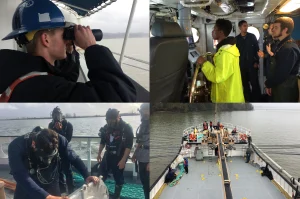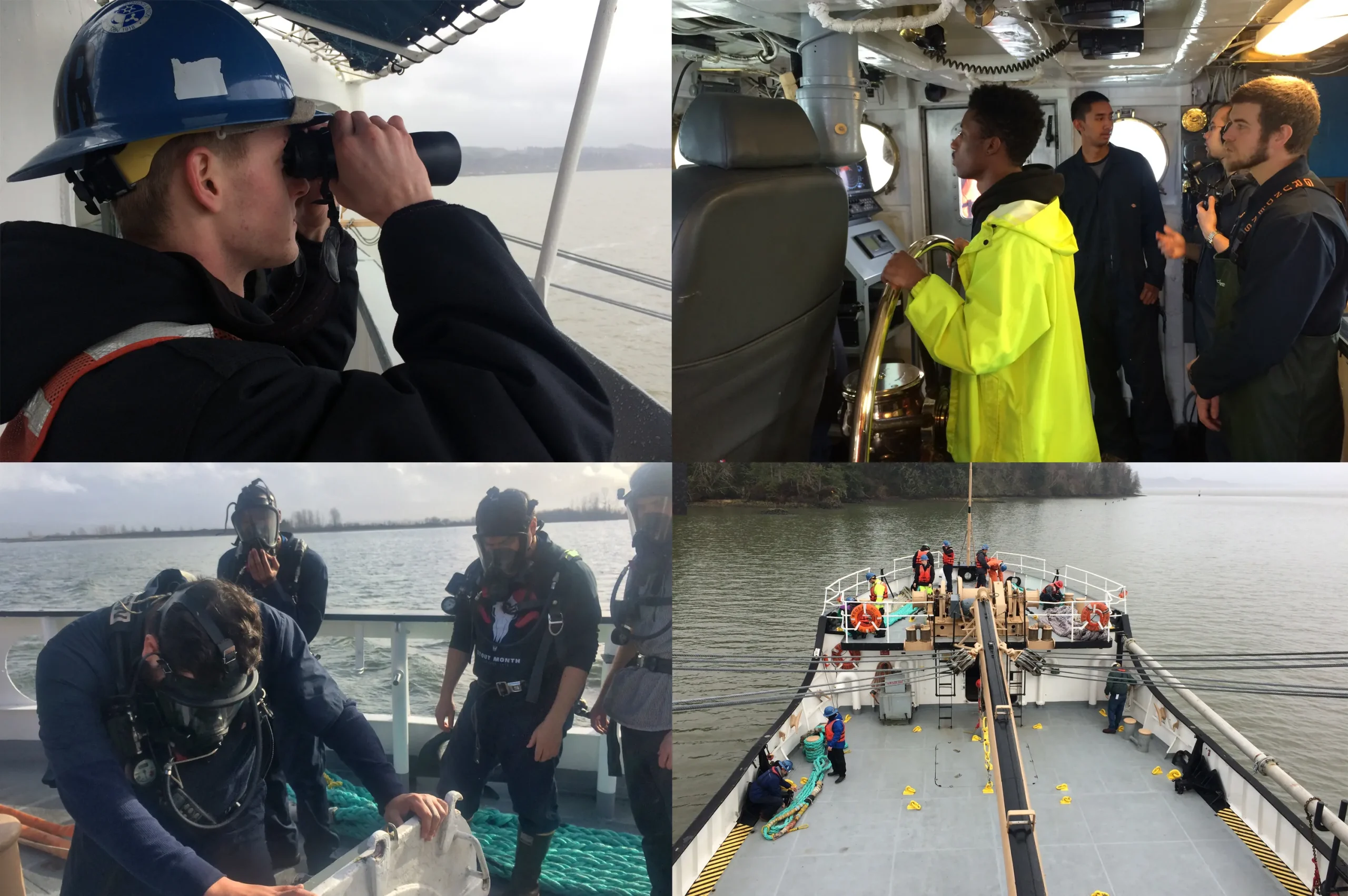Seamanship is one of the most essential and fundamental disciplines for ship officers, embodying the skills, knowledge, and practices needed to operate a vessel safely and efficiently. For officers navigating merchant ships, mastering the principles of Seamanship is critical to ensure not only the ship’s operational safety but also the well-being of the crew and the successful delivery of cargo. At maritime academies and universities, seamanship forms a core part of the curriculum, teaching cadets the day-to-day practices that maintain the ship, manage its crew, and handle all onboard tasks with competence. This article delves into the key components of seamanship, covering shipboard routines, watchkeeping, the use of ropes, wires, and anchors, and the practical maintenance and repair of equipment.

Shipboard Routines and Watchkeeping
Shipboard routines refer to the daily tasks and responsibilities carried out by the ship’s crew to ensure smooth operations. These routines are integral to the ship’s efficiency and safety, and officers are responsible for overseeing these activities.
- Watchkeeping
Watchkeeping is one of the most critical aspects of seamanship, particularly for officers on the bridge and in the engine room. A watch refers to the period when a crew member is on duty, monitoring the ship’s navigation, machinery, or security. Officers must be familiar with the principles of watchkeeping, including the rotation of watches, ensuring that those on duty are alert, and effectively monitoring all aspects of the ship’s operation.The bridge watch ensures the safe navigation of the ship, with officers responsible for steering, using navigational aids (such as radar, GPS, and ECDIS), and keeping lookout for other vessels or hazards. The engine room watch ensures the smooth functioning of the ship’s machinery, with engineers monitoring equipment, fuel consumption, and maintaining propulsion systems. - Logbook Entries
Officers are also tasked with maintaining an accurate logbook, a detailed record of the ship’s operations, including course changes, engine status, weather conditions, and any notable incidents. These entries are essential for legal and operational purposes and must be meticulously recorded during each watch.
Use of Ropes, Wires, and Anchors
One of the most practical aspects of seamanship is the safe and effective use of ropes, wires, and anchors. These tools are critical for docking, mooring, towing, and anchoring operations, and officers must be skilled in their proper handling and maintenance.
- Rope and Wire Handling
Seamanship requires a thorough understanding of the different types of ropes (or lines) and wires used onboard, including natural and synthetic fibers, as well as steel wires. Officers are trained in splicing (joining ropes), knot tying, and securing methods, which are essential for mooring the ship, securing cargo, or handling towing operations.Officers must also understand the safe working loads of ropes and wires, ensuring that they are not overloaded during use, which could lead to snapping or failure, posing serious safety risks to the crew. - Anchoring Techniques
Anchoring is a critical seamanship skill, allowing the ship to remain stationary in open water or at a designated anchorage. Officers must be adept at choosing an appropriate location to drop anchor, considering factors such as water depth, bottom type (rocky, sandy, or muddy), wind, and current. They must also calculate the scope of the anchor chain (the ratio of the chain length to water depth) to ensure the anchor holds securely.The process of weighing anchor (retrieving the anchor) is equally important, as officers must ensure that the anchor is properly secured before the ship resumes its voyage, preventing it from dragging along the seabed or causing damage to the ship’s hull.
Practical Seamanship: Maintenance and Repair of Equipment
Maintaining a ship and its equipment in optimal condition is one of the essential duties of a ship officer. Seamanship involves practical skills in maintenance and repair, ensuring that all systems and components onboard function safely and effectively.
- Hull and Deck Maintenance
Regular maintenance of the ship’s hull and deck is necessary to prevent corrosion, damage, or structural failure. Officers are responsible for inspecting the hull, especially after extended periods at sea, and organizing tasks such as chipping, painting, and cleaning to protect the ship from rust and wear.The deck must be kept free from hazards, such as oil spills, debris, or loose equipment, to ensure safe movement for the crew and prevent accidents. - Machinery and Equipment Maintenance
Ship officers must also oversee the maintenance of machinery and operational equipment, including winches, windlasses, cranes, and cargo handling systems. Regular checks, lubrication, and repair of moving parts are necessary to avoid breakdowns during critical operations such as docking, cargo loading, or anchoring.Maintenance of emergency equipment, such as lifeboats, firefighting systems, and life rafts, is another essential responsibility. Officers must ensure that all equipment is operational and readily accessible, conducting regular drills and inspections to ensure that the crew is prepared for emergencies.
Seamanship in Adverse Conditions
Seamanship also involves managing the ship in challenging weather or sea conditions. Officers must be skilled in heavy weather seamanship, which includes adjusting the ship’s speed and course in rough seas, securing cargo and equipment, and preparing the crew for challenging operations.
- Heavy Weather Operations
In rough seas, the officer on watch must adjust the ship’s heading and speed to reduce the impact of waves on the vessel. Techniques such as heaving to (slowing the ship down to ride out rough seas) and zigzagging to reduce rolling may be employed. These maneuvers help prevent damage to the ship and reduce discomfort for the crew. - Securing the Ship
During adverse conditions, it’s essential to secure loose objects, cargo, and equipment to prevent them from moving and causing damage or injury. Officers must ensure that all hatches, watertight doors, and ventilation systems are closed and secured to prevent flooding or ingress of seawater.
The Role of Leadership in Seamanship
A key aspect of seamanship is leadership. Officers are responsible for leading and organizing the crew in all shipboard activities, from routine maintenance to emergency procedures. Leadership in seamanship involves clear communication, delegation of tasks, and ensuring that every crew member is properly trained in their duties.
- Training and Drills
Officers must regularly conduct training sessions and drills to ensure that the crew is proficient in all aspects of seamanship, including fire safety, lifeboat launching, and emergency maneuvers. These drills are essential for maintaining crew readiness and ensuring that everyone can respond effectively in the event of an emergency. - Effective Communication
Communication is critical in seamanship, especially during operations such as mooring, towing, or navigating restricted waters. Officers must ensure that all crew members understand their roles and responsibilities and that any commands given are clear and concise. Effective communication reduces the likelihood of errors and enhances the efficiency and safety of ship operations.
Conclusion
Seamanship is at the heart of a ship officer’s responsibilities, encompassing a wide range of practical skills that ensure the safe and efficient operation of a vessel. From watchkeeping and rope handling to equipment maintenance and leadership, seamanship forms the foundation of a successful maritime career. Officers must master these skills to navigate the complexities of life at sea, ensuring that the ship, crew, and cargo are protected from the inherent risks of maritime operations. Through rigorous training in seamanship, officers develop the expertise and confidence needed to manage their ships in all conditions, maintaining the high standards of professionalism that are essential to the global shipping industry.

